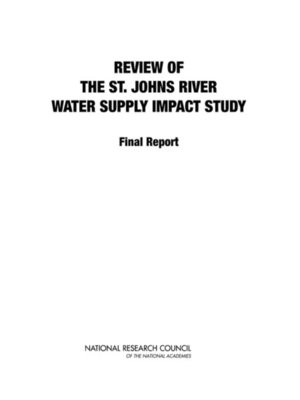Review of the St. Johns River Water Supply Impact Study
ebook ∣ Final Report
By National Research Council

Sign up to save your library
With an OverDrive account, you can save your favorite libraries for at-a-glance information about availability. Find out more about OverDrive accounts.
Find this title in Libby, the library reading app by OverDrive.



Search for a digital library with this title
Title found at these libraries:
| Library Name | Distance |
|---|---|
| Loading... |
The St. Johns River Water Management District is responsible for managing water resources in the St. Johns River basin, which comprises 23 percent of Florida. Approximately 4.73 million people (one-quarter of Florida's population) live in the area served by the District, which contains the growing cities of Jacksonville, Orlando, and Gainesville. In order to meet the increasing water supply needs of the District's residents and other water users, the District is considering supplementing its historical supply of groundwater with water from the St. Johns and Ocklawaha Rivers. To better understand the potential ecological impacts of such withdrawals, in 2008 the District began a large scientific study called the Water Supply Impact Study (WSIS).
In late 2008, the Water Science and Technology Board (WSTB) of the National Academies was asked to review the progress of the WSIS, including such scientific aspects as hydrologic and water quality modeling and how river withdrawals will affect wetlands, biogeochemical processes, plankton, benthos, the littoral zone, fish, and wetlands wildlife in the basin. For two and a half years, the WSTB Committee has followed the activities of eight District workgroups as they modeled the relevant river basins, determined the criteria to evaluate the environmental impacts of water withdrawals, evaluated the extent of those impacts, and coordinated with other ongoing projects. The first report of the Committee reviewed the Phase 1 hydrologic and environmental assessment tools and relevant data, and made recommendations regarding proposed work for the second phase of the WSIS. The Committee's second report focused on how the District was responding to the recommendations in its first report. The third Committee report primarily evaluated the hydrologic and hydrodynamic work being performed by the District. Review of the St. Johns River Water Supply Impact Study, the fourth and final product of the Committee focuses on the ecological impact analyses conducted by the environmental workgroups, presents final thoughts about the hydrologic and hydrodynamic studies, and provides some overall perspectives on the WSIS.







